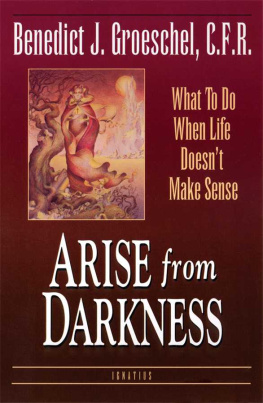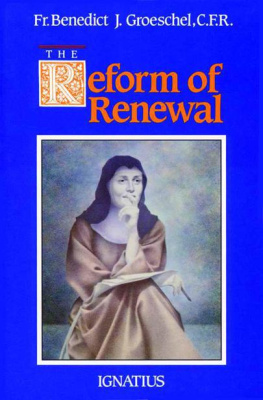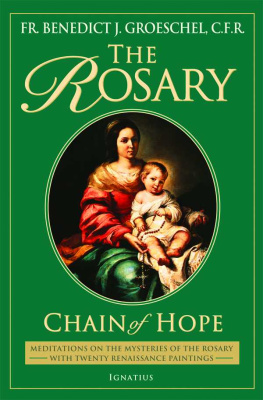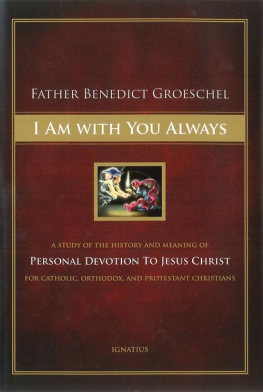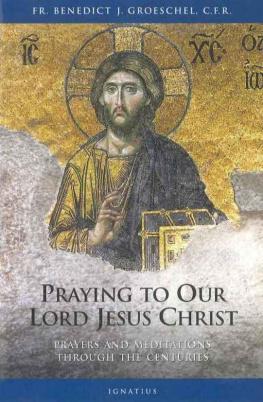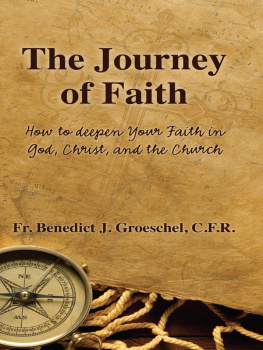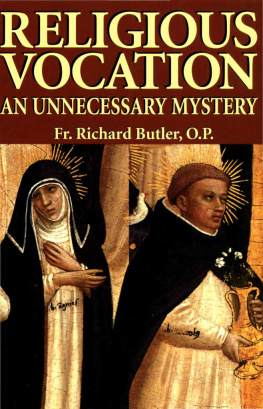A STILL, SMALL VOICE
FR. BENEDICT J. GROESCHEL, C.F.R.
A STILL, SMALL VOICE
A Practical Guide on Reported Revelations
And after the fire there was a still, small voice .
1 Kings 19:12
To ecstasy, I prefer the monotony of sacrifice .
Saint Thrse of Lisieux
IGNATIUS PRESS SAN FRANCISCO
Nihil Obstat:
James T. OConnor, S.T.D.
Censor Librorum
Imprimatur:
+ Patrick Sheridan, D.D.
Vicar GeneralArchdiocese of New York
November 30, 1992
The Nihil Obstat and Imprimatur are official declarations that a book or pamphlet is free of doctrinal or moral error. No implication is contained therein that those who have granted the Nihil Obstat and Imprimatur agree with the contents, opinions or statements expressed.
Cover art: St. Thrse of Lisieux by John Lynch
Cover design by Riz Boncan Marsella
1993 Ignatius Press, San Francisco
All rights reserved
ISBN 978-0-89870-436-5
Library of Congress catalogue number 92-74593
Printed in the United States of America
This book is gratefully dedicated to the many cloistered religious, nuns, and monks in English-speaking countries who have so generously supported my work and the Franciscans of the Renewal with their vigils, prayers, and the monotony of their sacrifices .
CONTENTS
ACKNOWLEDGMENTS
I am deeply grateful to the following friends who have helped so generously in making this book possible. As he has often done in the past, Charles Prendegast has corrected the manuscript and made many helpful suggestions, both as to style and content. Father Bernard Panczuk, O.S.B.M., provincial of the Basilian Monks, and Father Eugene Fulton, director of Trinity Retreat, have very kindly checked the manuscript. Elaine Barone has patiently done all the typing, and John Lynch has provided another of his fine paintings for the cover art. He has captured both the mysticism and struggles of Saint Thrse of Lisieux, whose simple insight has been so helpful in this matter of private revelation. I am also grateful to so many of my teachers and students who have shared their religious experiences with me over the years.
Fr. Benedict Joseph Groeschel, C.F.R.
St. Crispins Friary, Bronx, New York
Feast of the Sacred Heart of Jesus, 1992
INTRODUCTION
A Practical Guide
This book is meant to be a practical guide for those interested in private revelations and in reports of visions and other extraordinary religious phenomena. This interest may be personal, arising from ones own experience or from deep spiritual interest in the reports of others. The readers interest may also be more objective, arising from a legitimate curiosity or from a desire to help by guiding those who find themselves in these deep waters. Many readers have been profoundly influenced all their lives by the extraordinary experiences and visions of Saint Francis, Saint Teresa of Avila, or by Saint Margaret Marys mystical image of the Sacred Heart of Jesus. Few Catholics can claim honestly that they have not been influenced by the experience of Saint Bernadette at Lourdes.
At the present time there is a completely unexpected and incredibly diverse interest in what the psychologists of religion would call paranormal or paramystical phenomena. Bishops and priests, counselors and therapists, superiors and pastors, Protestant clergy and people in the media, and even relatives and friends are likely to be called upon to make a judgment or give an opinion on experiences that range from Medjugorje to the New Age. This book is meant to be a brief but comprehensive guide to all these inquirers and to open doors for those who feel that they need to know more.
My interest is both personal and objective. I have visited shrines and holy places, beginning with the Holy Land, and I have been gratefully filled with the pilgrims joy and fervor. I have also counseled some of those involved in questionable revelations, interviewed seers, and met skeptics turned ardent believers. I have even known a brilliant psychologist who in all innocence was the recipient of a false revelation.
For a number of years I have been working on a larger and more comprehensive book on the psychology of religious experience. In it I intend to review many studies of all kinds of religious phenomena. However, the intense interest in extraordinary religious experience at the present time has made me see that a concise practical book is urgently needed now. This is a bit of enlightened self-interest on my part.
I need something to save time when serious people earnestly, almost desperately, ask questions about what is happening to them and their friends. Candidly, I need to be able to hand someone a book. While not a comprehensive study of private revelation, this book will be, I hope, a helpful guide to the devout, the responsible, and even the merely curious.
A Review of Information Not Easily Available
For the most part, this book does not contain original material. It is derived from spiritual classics and from documents that are not readily available. I have drawn much from the standard work, The Graces of Interior Prayer by Father Augustin Poulain, S.J. This monumental study was first published in 1901 and went through at least ten editions up to 1922.
Does God Speak Now ?
Despite all the humbug arising from what is termed the New Age movement on the one hand, and the religious hype giving rise to endless reports of appearances of the Blessed Virgin on the other, an intelligent person who is not terrified by the unknown should be interested in something that elicits such widespread interest. A person concerned with his own spiritual life should be aware that God has visited his people throughout the ages, beginning with the prophets and continuing down through the history of the Church. These visitations do not add to the single, unique, and complete message of the Messiah, but apply and, as it were, highlight certain aspects of his teaching in different times and circumstances. In Christ are all the treasures of wisdom and knowledge (cf. Col 2:3), but he did send apostles like Peter and Paul to deliver this message with their own particular gifts. Can he not speak now through seers and even through others like creative teachers to renew the impact of the gospel? However, to make ones way through the confusing possibilities, to sort out all the subjective elements that individuals inevitably add, to discard the rubbish, to dismiss kindly those who with the best of intentions have been misled, and to filter out what is, in fact, a grace of Godall this is no small task.
An Alternative to Ecstasy
In my final chapter I offer an alternative to unusual and extraordinary ways of knowing the things of God. There is a normal, everyday opportunity open to those who seek God, called religious experience. This is the action of grace operating in the context of a human life. If we allow it, grace will elicit deeply-moving responses and become a powerful source of virtue. This is the meaning of the words of Saint Thrse of Lisieux:
To ecstasy, I prefer the monotony of sacrifice.
Notice she does not use the passive verb accept. She prefers the plain fulfillment of ones duties. The active reception of the innumerable signs of grace that surround us, the faithful carrying out of responsibilities, and the willingness to work on daily repentance make a symphony of religious experience, which is appreciated by those who are willing to take the time and make the effort. Perhaps many who are clinging to or seeking the reassurances given by extraordinary experience might be much better off if they knew how to grow and be enriched by the ordinary experience of God and the Holy which are available to all. Saint John of the Cross, the mystical Doctor of the Church, who warned people to assume that extraordinary experiences came from the forces of evil unless the opposite could be proved, would enthusiastically agree.
Next page

